Calculation of Temperature Fields in a Lithium Ceramic Pebble Bed during Reactor Irradiation in a Vacuum
Abstract
:1. Introduction
2. Calculation of the Effective Thermal Conductivity Coefficient of Lithium Ceramic Pebble Bed Depending on Helium Pressure for 2D and 3D Geometries
3. Modeling the Heating of a Real Irradiation Device Filled with Two-Phase Lithium Ceramics Pebble Bed during Neutron Irradiation in a Vacuum
4. Conclusions
Author Contributions
Funding
Conflicts of Interest
References
- Tanabe, T. Tritium: Fuel of Fusion Reactors; Springer: Tokyo, Japan, 2017. [Google Scholar]
- Ananchenko, D.V.; Nikiforov, S.V.; Sobyanin, K.V.; Konev, S.F.; Dauletbekova, A.K.; Akhmetova-Abdik, G.; Akilbekov, A.T.; Popov, A.I. Paramagnetic Defects and Thermoluminescence in Irradiated Nanostructured Monoclinic Zirconium Dioxide. Materials 2022, 15, 8624. [Google Scholar] [CrossRef]
- Ibarra, A.; Hodgson, E.R. The ITER project: The role of insulators. Nucl. Instrum. Methods B 2004, 218, 29–35. [Google Scholar] [CrossRef]
- Gonzales de Vicente, S.M.; Hodgson, E.R.; Shikama, T. Functional materials for tokamak in-vessel systems—Status and applications. Nucl. Fusion 2017, 57, 092009. [Google Scholar] [CrossRef]
- Seeman, V.; Feldbach, E.; Kärner, T.; Maaroos, A.; Mironova-Ulmane, N.; Popov, A.I.; Lushchik, A. Fast-neutron-induced and as-grown structural defects in magnesium aluminate spinel crystals with different stoichiometry. Opt. Mater. 2019, 91, 42–49. [Google Scholar] [CrossRef]
- Monge, M.A.; Gonzalez, R.; Santiuste, J.M.; Pareja, R.; Chen, Y.; Kotomin, E.A.; Popov, A.I. Photoconversion of F+ centers in neutron-irradiated MgO. Nucl. Instrum. Methods Phys. Res. Sect. B Beam Interact. Mater. At. 2000, 166, 220–224. [Google Scholar] [CrossRef]
- Oyaidzu, M.; Kimura, H.; Yoshikawa, A.; Nishikawa, Y.; Munakata, K.; Okada, M.; Nishikawa, M.; Okuno, K. Correlation between annihilation of irradiation defects and tritium release in neutron-irradiated lithium zirconate. Fusion Eng. Des. 2006, 81, 583–588. [Google Scholar] [CrossRef]
- Moritani, K.; Magari, T.; Moriyama, H. Tritium release kinetics of lithium silicates with irradiation defects. Fusion Eng. Des. 1998, 39–40, 675–683. [Google Scholar] [CrossRef]
- Giancarli, L.M.; Abdou, M.; Campbell, D.J.; Chuyanov, V.A.; Ahn, M.Y.; Enoeda, M.; Pane, C.; Poitevin, Y.; Rajendra Kumar, E.; Ricapito, I.; et al. Overview of the ITER TBM Program. Fusion Eng. Des. 2012, 87, 395–402. [Google Scholar] [CrossRef]
- Danani, C.; Swami, H.L.; Chaudhuri, P.; Mutzke ASchneider, R.; Warrier, M. Multi-model quantification of defects in irradiated lithium titanate. Fusion Eng. Des. 2019, 140, 92–96. [Google Scholar] [CrossRef]
- Knitter, R.; Chaudhuri, P.; Feng, Y.J.; Hoshino, T.; Yu, I.-K. Recent developments of solid breeder fabrication. J. Nucl. Mater. 2013, 442, 420–424. [Google Scholar] [CrossRef]
- Moriyama, H.; Tanaka, S.; Noda, K. Irradiation effects in ceramic breeder materials. J. Nucl. Mater. 1998, 258–263, 587–594. [Google Scholar] [CrossRef]
- Kotomin, E.A.; Popov, A.I. Radiation-induced point defects in simple oxides. Nucl. Instrum. Methods Phys. Res. 1998, 141, 1–15. [Google Scholar] [CrossRef]
- Kotomin, E.; Kuzovkov, V.; Popov, A.I.; Maier, J.; Vila, R. Anomalous kinetics of diffusion-controlled defect annealing in irradiated ionic solids. J. Phys. Chem. A 2018, 122, 28–32. [Google Scholar] [CrossRef]
- Hollenberg, G.; Kurasawa, T.; Berk, S.; Hastings, I. A Fast Neutron, In situ Tritium Recovery Experiment on Solid Breeder Materials. J. Fusion Technol. 1989, 15, 1349–1354. [Google Scholar] [CrossRef]
- Kurasawa, T.; Slagle, O.; Hollenberg, G.; Verrall, R. In situ tritium recovery from Li2O irradiated in fast neutron flux—BEATRIX II initial results. J. Fusion Technol. 1991, 19, 931–937. [Google Scholar] [CrossRef]
- Van der Laan, J.G.; Kwast, H.; Stijkel, M.; Conrad, R.; May, R.; Casadio, S.; Roux, N.; Werle, H.; Verrall, R.A. EXOTIC-7: Irradiation of ceramic breeder materials to high lithium burnup. J. Nucl. Mater. 1996, 233–237, 1446–1451. [Google Scholar] [CrossRef]
- Peeters, M.M.W.; Magielsen, A.J.; Stijkel, M.P.; van der Laan, J.G. In-pile tritium release behaviour of lithium metatitanate produced by extrusion–spheroidisation–sintering process in EXOTIC-9/1 in the high flux reactor, Petten. Fusion Eng. Des. 2007, 82, 2318–2325. [Google Scholar] [CrossRef]
- Tsuchiya, K.; Nakamichi, M.; Nagao, Y.; Fujita, J.; Sagawa, H.; Tanaka, S.; Kawamura, H. Integrated experiment of blanket in-pile mockup with Li2TiO3 pebbles. Fusion Eng. Des. 2000, 51–52, 887–892. [Google Scholar] [CrossRef]
- Zhou, O.; Sun, F.; Hirata, S.; Li, S.; Li, Y.; Oya, Y. Effect of neutron dose on the tritium release behavior of Li2TiO3–0.5Li4SiO4 biphasic ceramic. Int. J. Hydrogen Energy 2023, 48, 4363–4370. [Google Scholar] [CrossRef]
- Yang, M.; Zhao, L.; Qin, Y.; Ran, G.; Gong, Y.; Wang, H.; Xiao, C.; Chen, X.; Lu, T. Tritium release property of Li2TiO3-Li4SiO4 biphasic ceramics. J. Nucl. Mater. 2020, 538, 152268. [Google Scholar] [CrossRef]
- Yang, M.; Zhao, L.; Ran, G.; Gong, Y.; Wang, H.; Peng, S.; Xiao, C.; Chen, X.; Lu, T. Tritium release behavior of Li2TiO3 and 2Li2TiO3-Li4SiO4 biphasic ceramic pebbles fabricated by microwave sintering. Fusion Eng. Des. 2021, 168, 112390. [Google Scholar] [CrossRef]
- Kolb, M.H.H.; Rolli, R.; Knitter, R. Tritium adsorption/release behaviour of advanced EU breeder pebbles. J. Nucl. Mater. 2017, 489, 229–235. [Google Scholar] [CrossRef]
- Kulsartov, T.; Shaimerdenov, A.; Zaurbekova, Z.; Knitter, R.; Chikhray, Y.; Askerbekov, S.; Akhanov, A.; Kenzhina, I.; Aitkulov, M.; Sairanbayev, D.; et al. Investigation of transient processes of tritium release from biphasic lithium ceramics Li4SiO4-Li2TiO3 at negative neutron flux pulse. Nucl. Mater. Energy 2023, 36, 101489. [Google Scholar] [CrossRef]
- Tazhibayeva, I.; Kulsartov, T.; Barsukov, N.; Gordienko, Y.; Ponkratov, Y.; Zaurbekova, Z.; Tulubayev, E.; Gnyrya, V.; Baklanov, V.; Kenzhin, E. Interaction of tritium and helium with lead–lithium eutectic under reactor irradiation. Fusion Eng. Des. 2014, 89, 1486–1490. [Google Scholar] [CrossRef]
- Tazhibayeva, I.L.; Kulsartov, T.V.; Baklanova, Y.Y.; Zaurbekova, Z.A.; Gordienko, Y.; Ponkratov, Y.V. Reactor studies of tritium release from lead-lithium eutectic Li15.7Pb with deuterium over the sample. Nucl. Mater. Energy 2020, 25, 100868. [Google Scholar] [CrossRef]
- Chikhray, Y.; Shestakov, V.; Maksimkin, O.; Turubarova, L.; Osipov, I.; Kulsartov, T.; Kuykabayeba, A.; Tazhibayeva, I.; Kawamura, H.; Tsuchiya, K. Study of Li2TiO3 + 5 mol% TiO2 lithium ceramics after long-term neutron irradiation. J. Nucl. Mater. 2009, 386–388, 286–289. [Google Scholar] [CrossRef]
- Cruz, D.; Bulbulian, S. Synthesis of Li4SiO4 by a modified combustion method. J. Am. Ceram. Soc. 2005, 88, 1720–1724. [Google Scholar] [CrossRef]
- Cruz, D.; Bulbulian, S.; Lima, E.; Pfeiffer, H. Kinetic analysis of the thermal stability of lithium silicates (Li4SiO4 and Li2SiO3). J. Solid State Chem. 2006, 179, 909–916. [Google Scholar] [CrossRef]
- COMSOL Multiphysics Simulation Software/Software Developers Website. Available online: https://www.comsol.com/comsol-multiphysics (accessed on 11 May 2023).
- Ganta, D.; Dale, E.B.; Rezac, J.P.; Rosenberger, A.T. Optical method for measuring thermal accommodation coefficients using a whispering-gallery microresonator. J. Chem. Phys. 2011, 135, 084313. [Google Scholar] [CrossRef]
- Leys, O.; Leys, J.M.; Knitter, R. Current status and future perspectives of EU ceramic breeder development. Fusion Eng. Des. 2021, 164, 112171. [Google Scholar] [CrossRef]
- Pupeschi, S.; Moscardini, M.; Gan, Y.; Knitter, R.; Kamlah, M. Cyclic behavior of ceramic pebble beds under mechanical loading. Fusion Eng. Des. 2018, 134, 11–21. [Google Scholar] [CrossRef]
- Pupeschi, S.; Knitter, R.; Kamlah, M. Effective thermal conductivity of advanced ceramic breeder pebble beds. Fusion Eng. Des. 2017, 116, 73–80. [Google Scholar] [CrossRef]
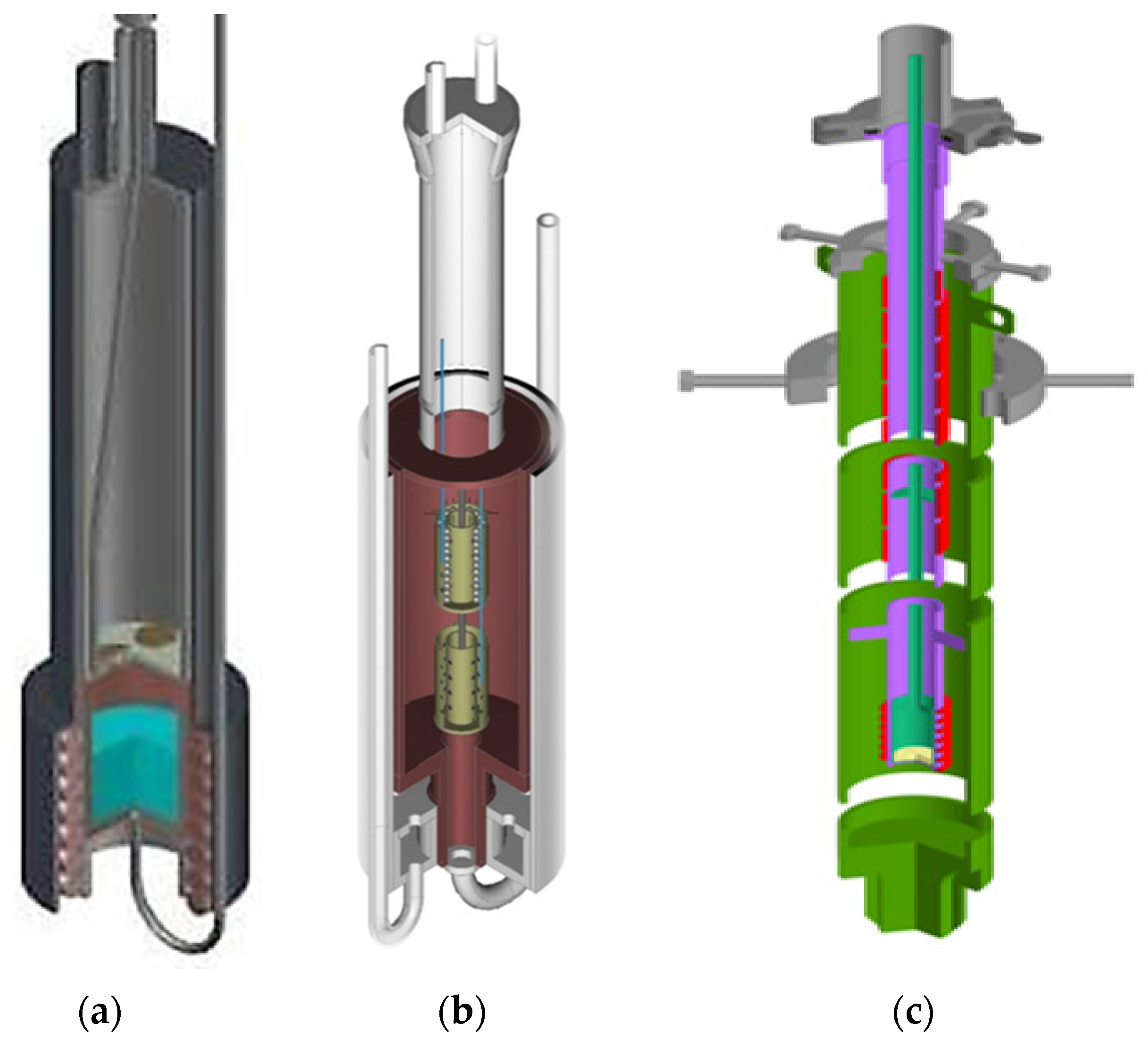

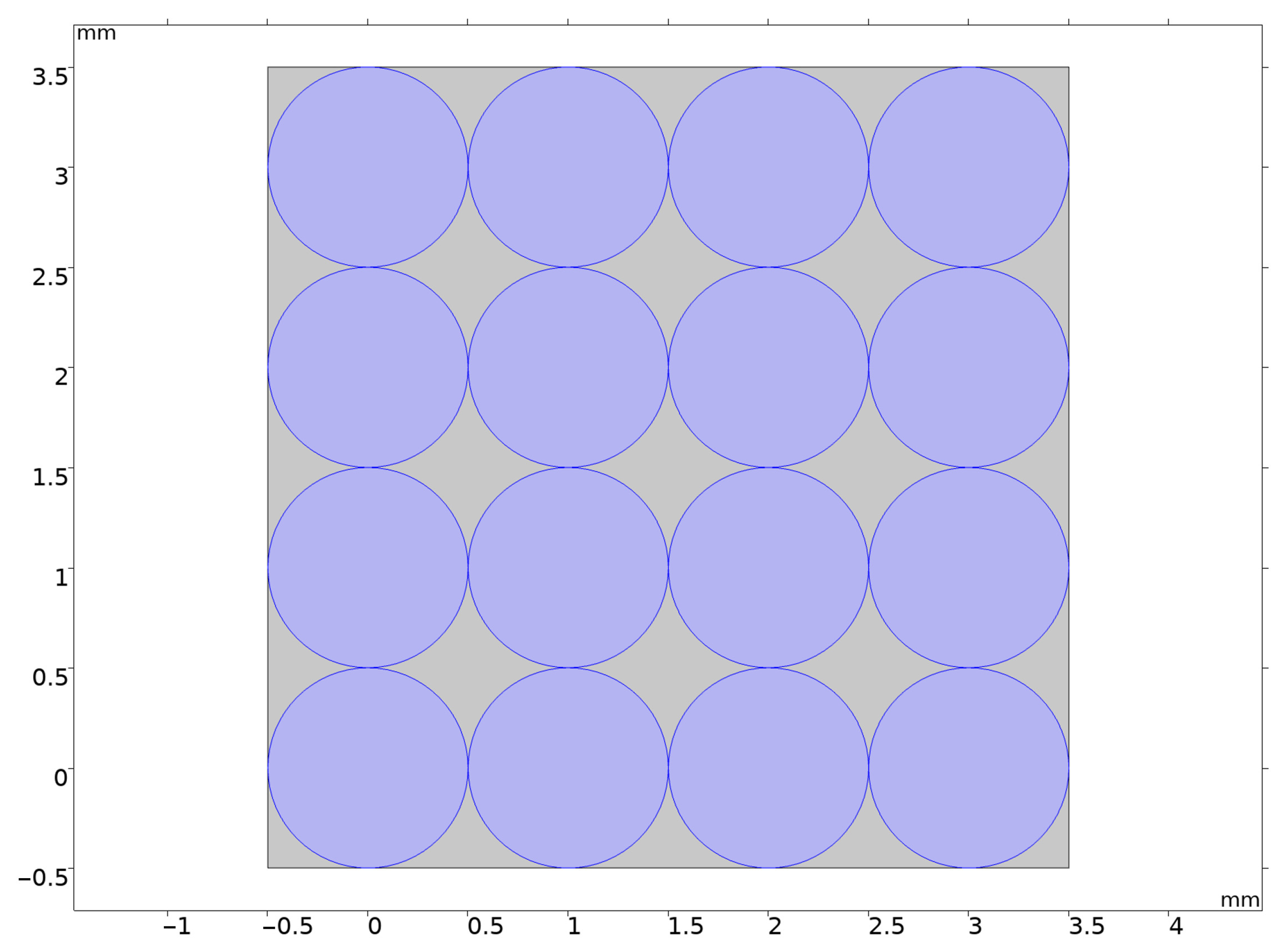


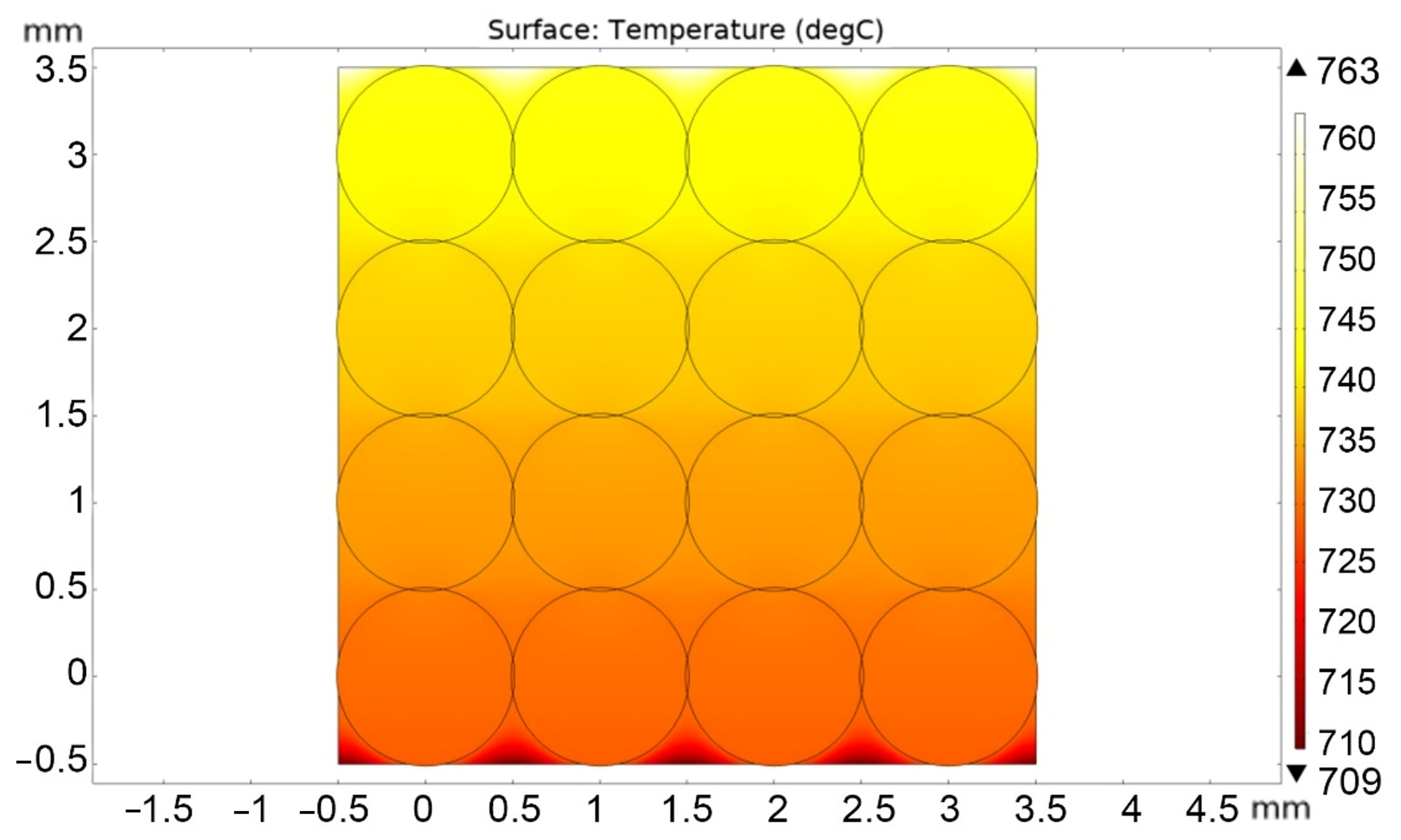

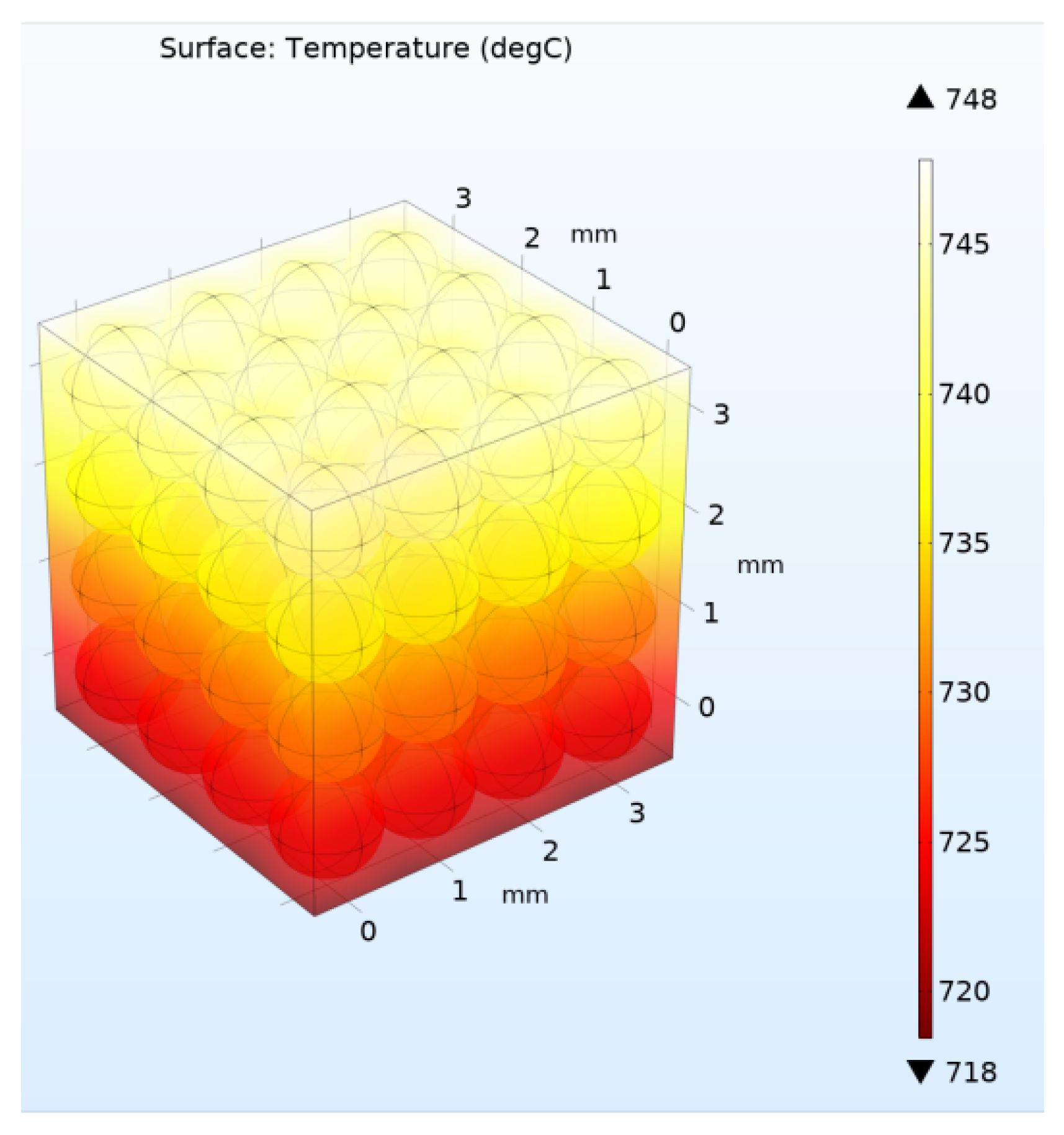

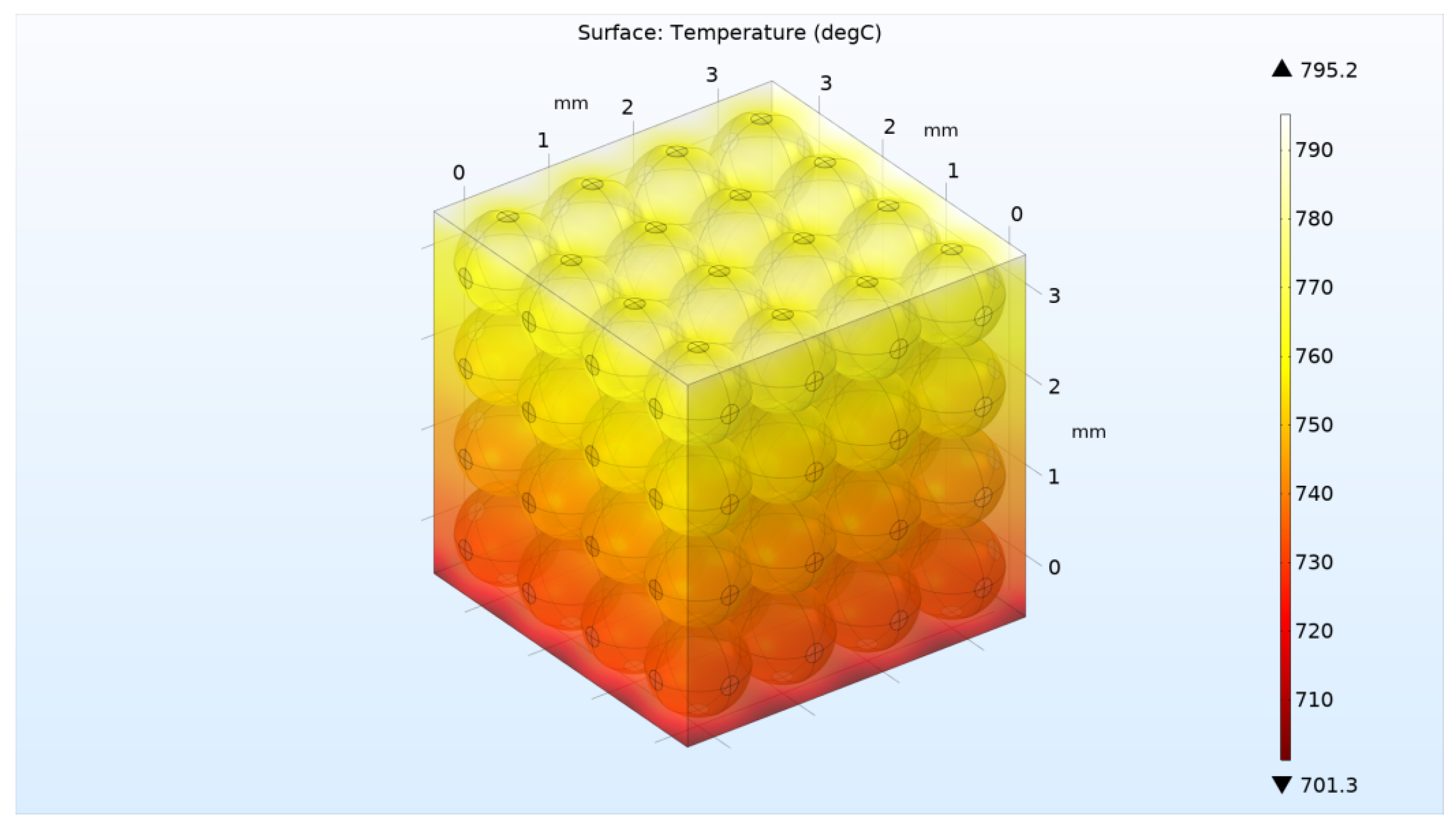
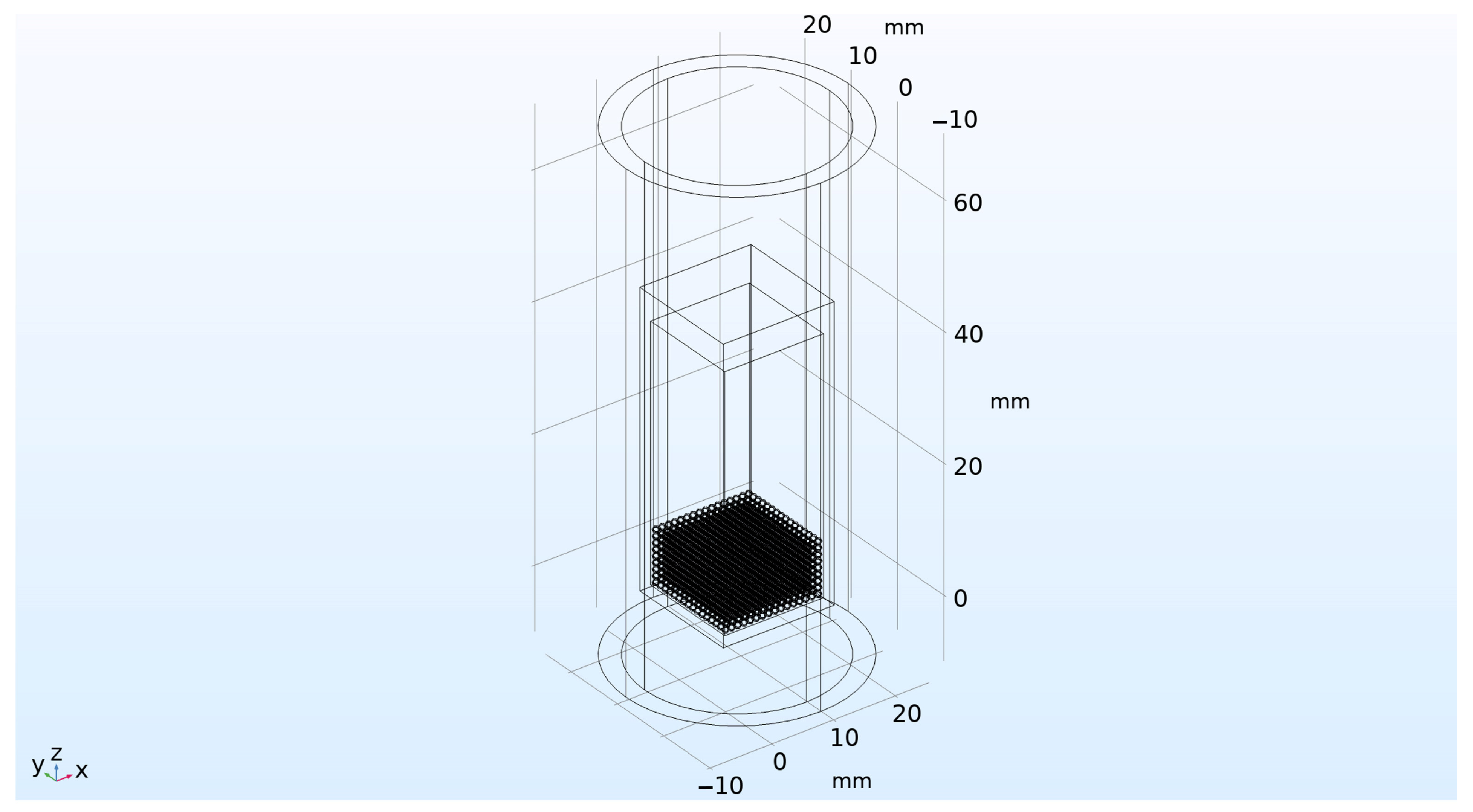

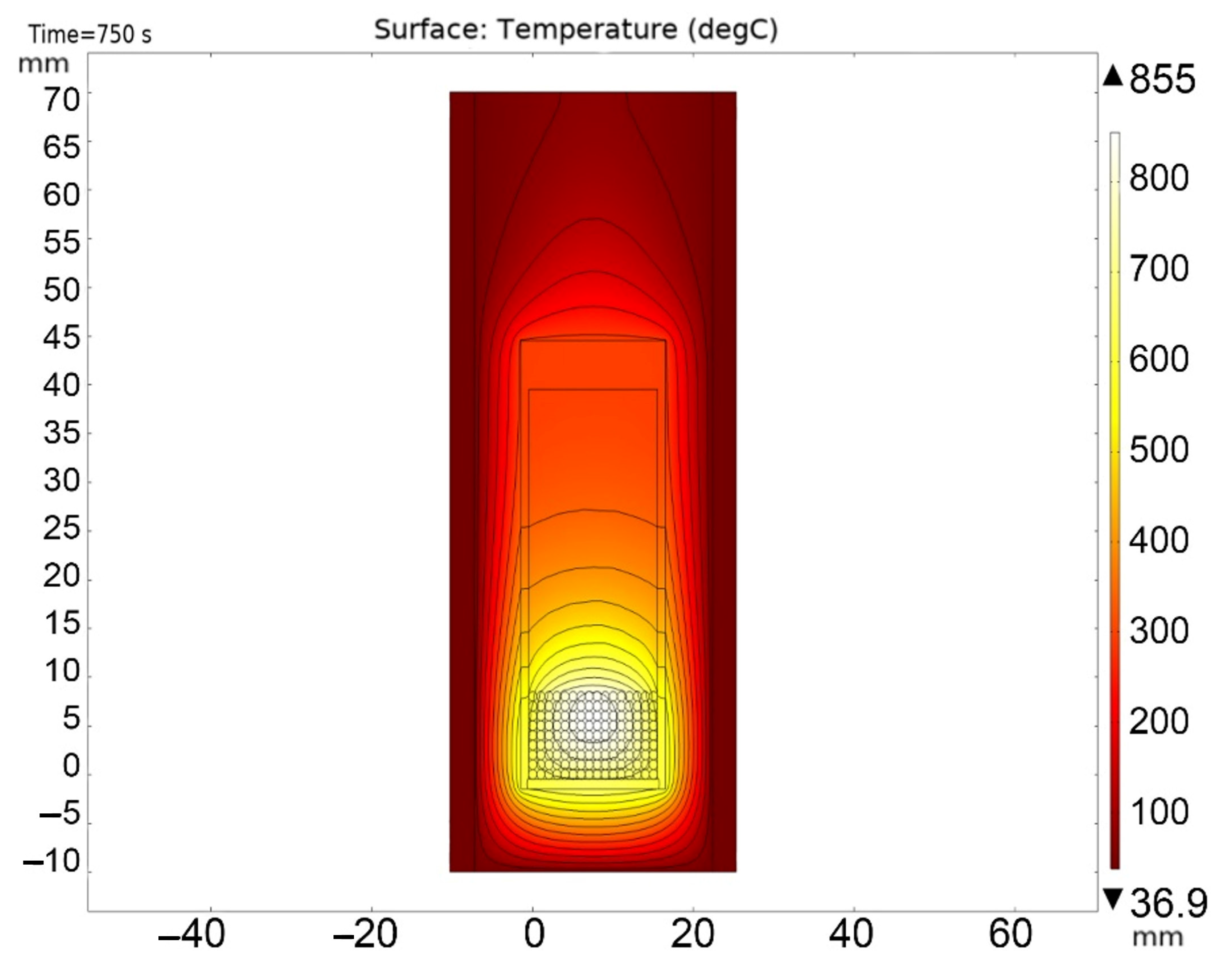
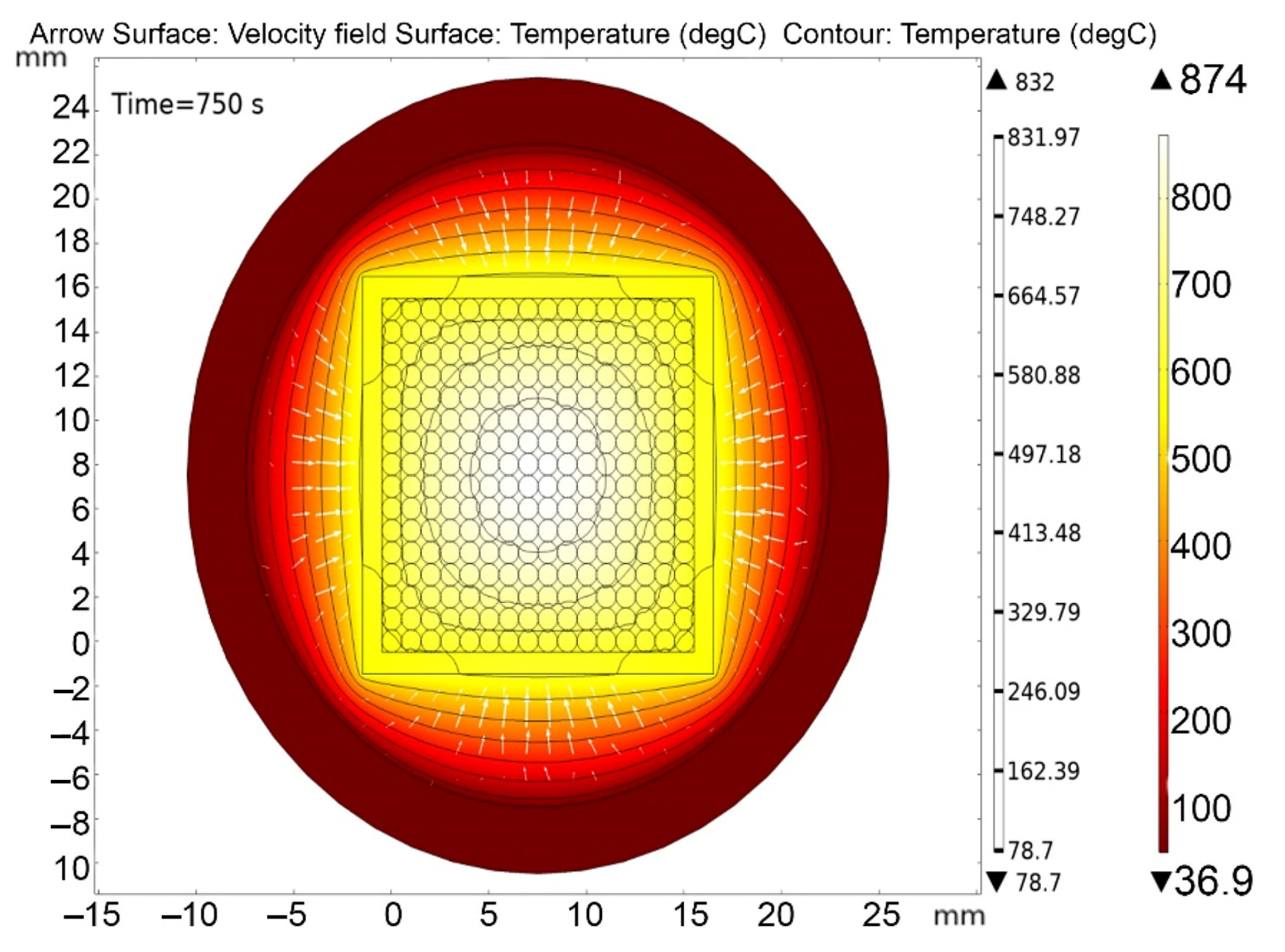
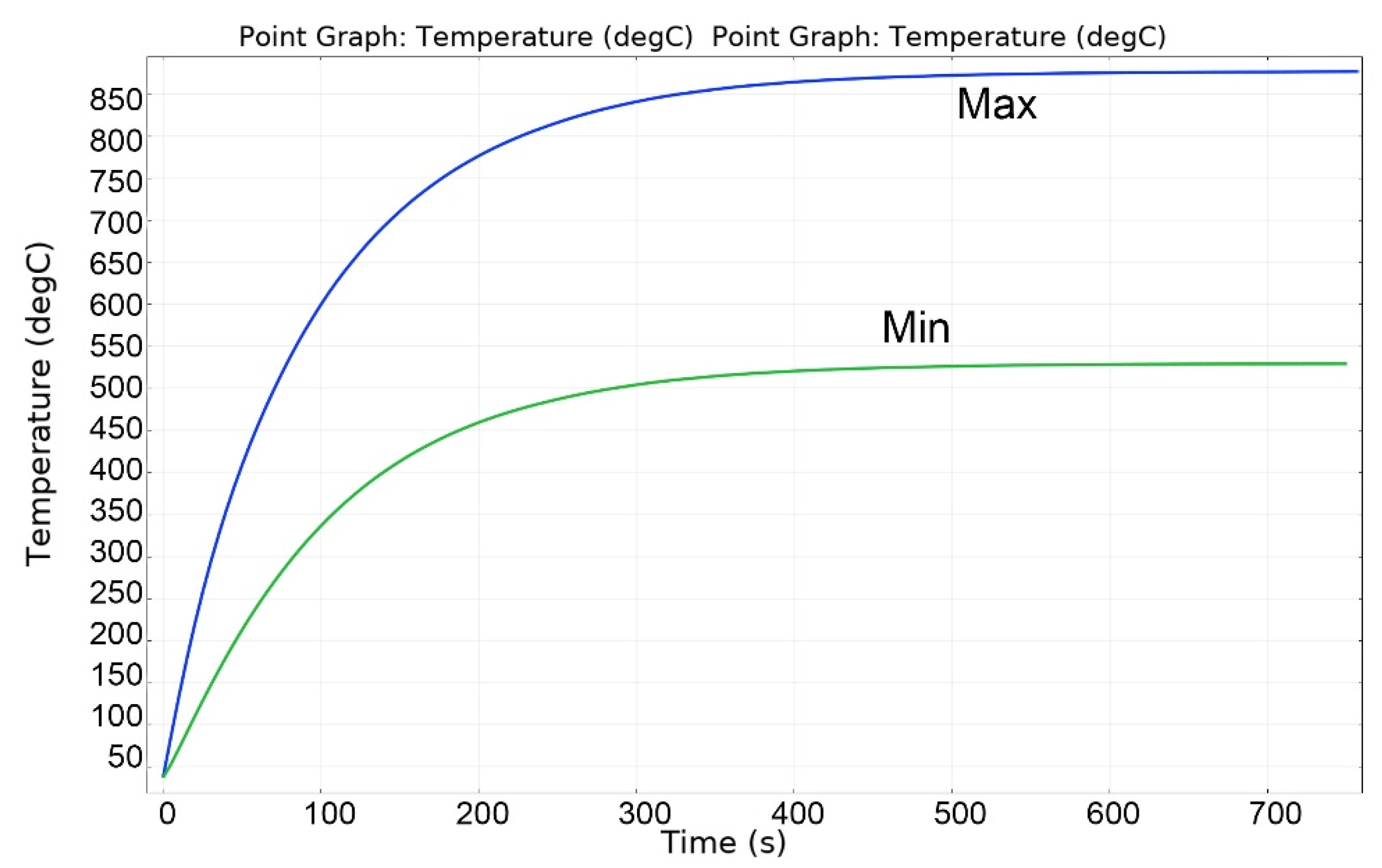



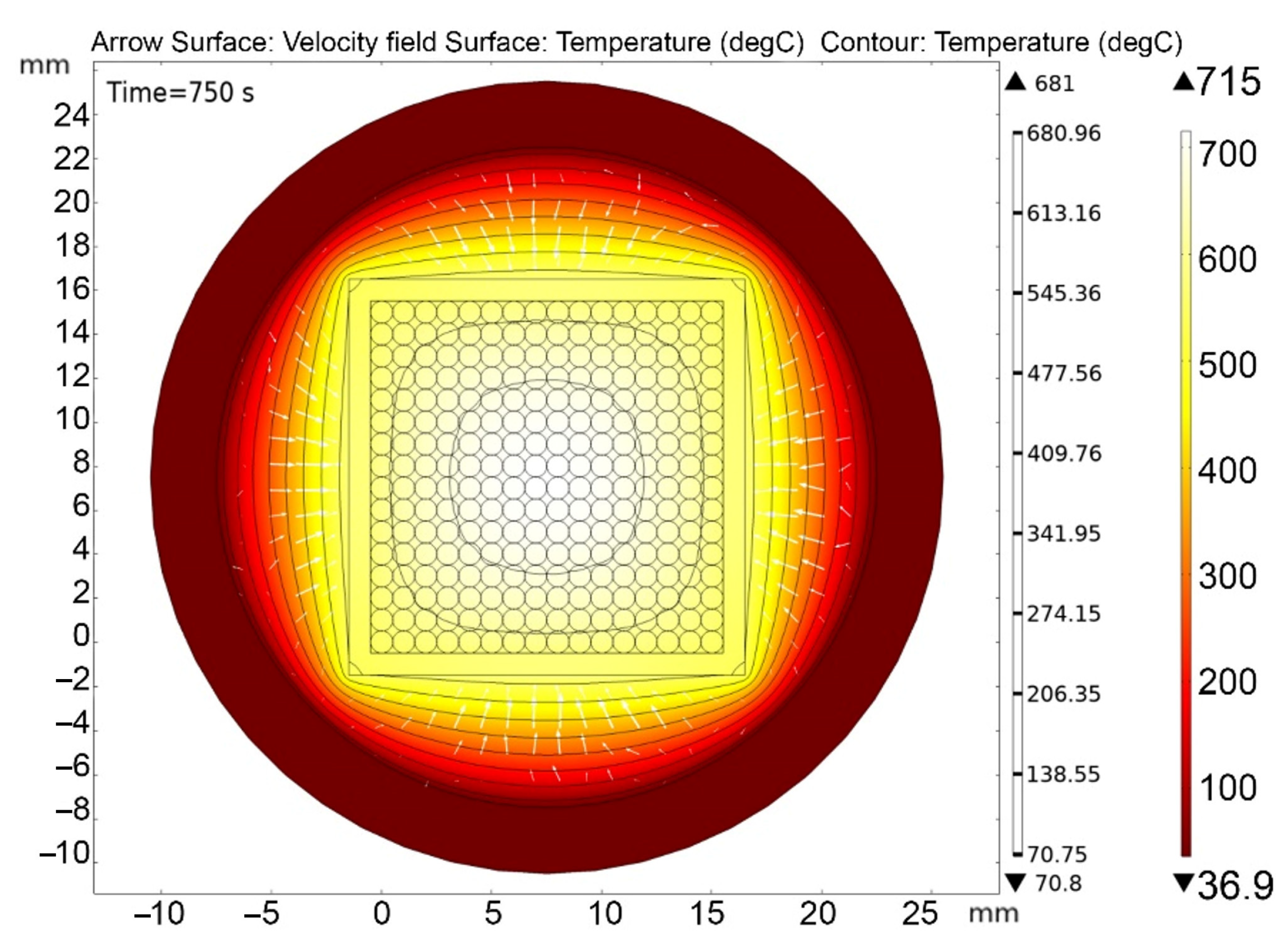


Disclaimer/Publisher’s Note: The statements, opinions and data contained in all publications are solely those of the individual author(s) and contributor(s) and not of MDPI and/or the editor(s). MDPI and/or the editor(s) disclaim responsibility for any injury to people or property resulting from any ideas, methods, instructions or products referred to in the content. |
© 2023 by the authors. Licensee MDPI, Basel, Switzerland. This article is an open access article distributed under the terms and conditions of the Creative Commons Attribution (CC BY) license (https://creativecommons.org/licenses/by/4.0/).
Share and Cite
Chikhray, Y.; Kulsartov, T.; Zaurbekova, Z.; Kenzhina, I.; Samarkhanov, K. Calculation of Temperature Fields in a Lithium Ceramic Pebble Bed during Reactor Irradiation in a Vacuum. Materials 2023, 16, 6914. https://doi.org/10.3390/ma16216914
Chikhray Y, Kulsartov T, Zaurbekova Z, Kenzhina I, Samarkhanov K. Calculation of Temperature Fields in a Lithium Ceramic Pebble Bed during Reactor Irradiation in a Vacuum. Materials. 2023; 16(21):6914. https://doi.org/10.3390/ma16216914
Chicago/Turabian StyleChikhray, Yevgen, Timur Kulsartov, Zhanna Zaurbekova, Inesh Kenzhina, and Kuanysh Samarkhanov. 2023. "Calculation of Temperature Fields in a Lithium Ceramic Pebble Bed during Reactor Irradiation in a Vacuum" Materials 16, no. 21: 6914. https://doi.org/10.3390/ma16216914





